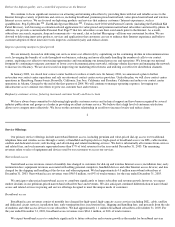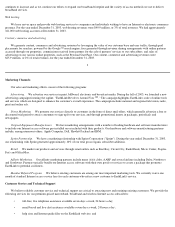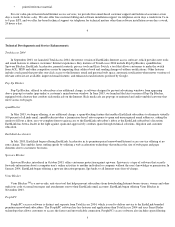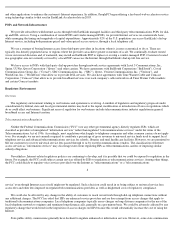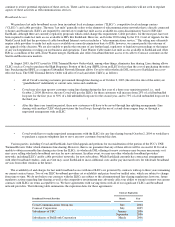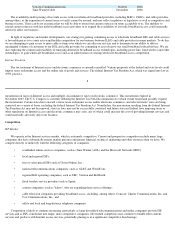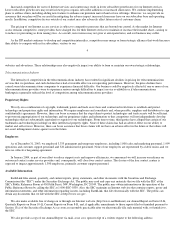Earthlink 2003 Annual Report Download - page 15
Download and view the complete annual report
Please find page 15 of the 2003 Earthlink annual report below. You can navigate through the pages in the report by either clicking on the pages listed below, or by using the keyword search tool below to find specific information within the annual report.
14
substantially all revenues from services, primarily Internet access services, and related fees, and such revenues represented 97% or more of
total revenues for each of the three years in the period ended December 31, 2003. The remaining revenues relate to sales of equipment and
devices used by our subscribers to access our services.
The Internet access market in the U.S. grew dramatically from the mid-1990's through 2000 but has experienced slower growth since as
the market has reached a mature stage of growth. Approximately 70 million households are estimated to have had Internet access services at
December 31, 2003, and about three to four million new households are currently adding Internet access each year. Within the total Internet
access market, the market for traditional, fully-featured, unlimited narrowband dial-up access services, which are typically priced at $17.95 to
$23.95 per subscriber per month, is shrinking but is the most common service. Focused, value-priced narrowband access providers offer
services with a limited set of features priced typically at $9.95 to $14.95 per month and are currently demonstrating an ability to grow by
attracting households new to the Internet or current Internet users interested in reducing their cost of Internet access. Broadband or high-speed
access is typically priced at $30 to $50 per month and is growing rapidly, having added an estimated six million households in 2003 to an
estimated total of 22 million households at the end of 2003. The largest competitors in broadband access are the cable companies and regional
bell operating companies ("RBOCs") offering broadband access over their own cable or telephone lines.
EarthLink provides all three types of access described above (traditional, fully-featured narrowband access; value-priced narrowband
access; and broadband access). Our subscriber base grew from approximately 5.0 million paying subscribers at December 31, 2002 to
approximately 5.2 million paying subscribers at December 31, 2003. Total revenues increased from $1,357.4 million during the year ended
December 31, 2002 to $1,401.9 million during the year ended December 31, 2003. While our overall subscriber base grew over the last year,
the mix of customers has shifted toward broadband services, reflecting the growth of this component of the Internet access market and our
expanding broadband footprint and offerings, and toward value-priced Internet access services resulting from the acquisition of PeoplePC Inc.
("PeoplePC"). Our traditional, premium-
priced narrowband subscriber base has been declining reflecting the increasing maturity of this service.
Our goal is to sustain and build upon our strong position in the U.S. Internet access market by focusing on high-growth opportunities such
as broadband and value-priced narrowband access to generate organic subscriber growth; providing a high-quality customer experience,
including a full range of Internet access services and innovative applications; improving operating margins to fund growth; and emphasizing
customer service.
We operate in a highly competitive market for each of our service offerings, and the competitive environment impacts the churn rates we
experience as well as the number of new customers we are able to add. Churn measures the percentage of customers that discontinue EarthLink
services, and management uses churn rates to assess the quality of EarthLink's service offerings and/or to estimate the life of a customer.
Because we operate in a highly competitive environment, we may experience high levels of churn as a result of events beyond our control. In
addition, competitors may use aggressive marketing efforts to attract new subscribers which may adversely impact the number of customers we
are able to add. However, to attract and retain customers, we continue to focus on improving the high-quality Internet experience EarthLink
offers, including providing superior customer and technical service and differentiating our products and services with innovative and useful
tools that improve the Internet experience. We also continue to seek out new marketing partners, such as Best Buy and RadioShack, in our
efforts to compete more effectively in adding customers and expand our distribution opportunities. Nonetheless, we expect our customer mix
will continue to shift from premium narrowband to value-priced narrowband and high-speed Internet access services, although more modestly
than the rates experienced over the previous two years. We also expect competitive pressures will result in continued aggressive promotional
pricing
15
offers on our premium narrowband and broadband access service offerings, which may adversely impact our ability to grow revenues.
One component of EarthLink's strategy for increasing its broadband customer base is to ensure it can cost-effectively purchase wholesale
broadband access. EarthLink's strategy for gaining continuing, cost-effective wholesale broadband access is to create active and healthy
competition for EarthLink's business between incumbent local exchange carriers ("ILEC"s) (including RBOCs) and cable providers in major
markets. However, we continue to experience resistance from RBOCs and cable providers in gaining cost-effective, wholesale access to their
networks over which we could provide our high-speed access services. We have agreements with many of the RBOCs for wholesale access;
however, we continue to observe competitive retail pricing by the RBOCs for high-speed access without corresponding declines in the prices
for wholesale access, which inhibits our ability to compete on a cost-
effective basis. Cable providers have generally resisted granting EarthLink
wholesale access to their networks to provide high-speed access services. Cable providers have not been required by law to make access
available. While an October 2003 ruling by the U.S. Court of Appeals for the Ninth Circuit may ultimately require cable providers to make last
mile access available to ISPs, we cannot predict the outcome of any appeals of this decision. EarthLink is also exploring the commercial
feasibility of emerging alternative broadband access technologies to gain wholesale broadband access and as an added means of creating
wholesale broadband access competition.


